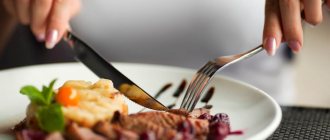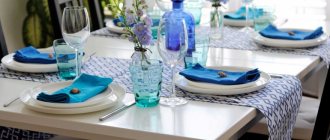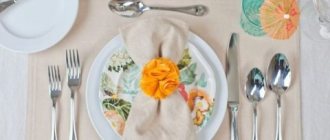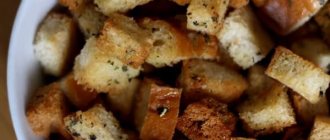Every housewife can create a cozy atmosphere during a meal. Serving is a simple science; it is enough to know the basic rules of etiquette. Any dish will seem tastier at an elegantly decorated table.
Since ancient times, celebrations have been accompanied by feasts, and it was then that customs and rules for table setting began to take shape.
On which side of the plate should the fork be placed according to etiquette?
Restaurant etiquette is a delicate art that deserves careful study. Not only workers and frequent visitors to the service industry should be familiar with some basic rules and features of this area in order to avoid possible awkward situations when serving on their own. It is necessary to learn in advance about the methods of serving cutlery and other important details that are of great importance in table etiquette.
Peculiarities
There are a number of consistent nuances when decorating a table:
- The serving process begins with the selection of the necessary utensils. The number of forks, spoons and knives depends directly on the number of guests and the dishes served, but it is important to remember that mixing and taking out the entire collection of cutlery available in the arsenal is inappropriate.
- You should select the right cutlery, also taking into account the formality of the reception, the expected guests and the size of the table.
- There are three types of sets: basic, snack and dessert. Every home definitely has a basic set. Any of the sets necessarily includes a spoon, fork and knife, but the sizes of the cutlery will vary greatly.
- Serving may vary depending on the theme of the reception, the food served and the size of the event.
Additional decorations for serving
The decor should not be conspicuous; it complements the serving of dishes. Inappropriate:
- high compositions;
- vases with huge bouquets blocking the view;
- strong-smelling bouquets; guests may be allergic to them.
Decorate with napkin holders and candlesticks. Originally folded fabric napkins are an ideal option for decorating a formal table. Flowers from vegetables and fruits, edible compositions are appropriate for any dinner, they have a place on the dessert table.
A win-win option is to use flowers. Usually they are placed in the middle of the table - it can be a bouquet or composition.
Knowing the secrets of serving, you can turn a traditional meal into a wonderful meal, where everyone will enjoy not only the food, but also the contemplation of the feast. It's so easy to give joy to your loved ones! Make every family lunch and dinner special.
How to pre-serve?
When starting to set the table, it is also worth knowing that there are different options: basic, formal and informal table setting. Each type should be considered in more detail:
- Basic serving includes the mandatory presence of a “base”. The basic set assumes the presence of a plate, fork, spoon, knife, glass of water and napkins. If the first courses are not planned to be served for the entire meal, a spoon can easily be excluded from this list.
- The informal serving style is suitable for lunch with friends or a themed brunch. In this case, a large number of snack plates are added, and therefore, cutlery, glasses or other types of vessels for drinks.
- The formal serving option assumes formal events as an occasion: celebrating memorable events, holidays, lunches with colleagues or meals during negotiations.
In this case, cutlery is most often changed and served more than once during the evening, which includes separate serving options for dessert dishes and tea drinking.
The biggest difficulties arise when distributing devices. Here it is worth remembering the basic rule : the sequence of arrangement of cutlery reflects the order of their use , therefore, on the outside of the plate, the first cutlery for the guest will be the cutlery for appetizers or any other dish served first. Cutlery is always distributed around the main course plate. If you remember this one rule, you can already avoid many awkward situations when setting the table for dinner or any other meal yourself.
To show your deeper knowledge, it is enough to understand which side to put various devices on. And here I have my own conventions. For example, knives, even if there are several of them, are always placed on the right side of the plate. Their blades always face the plate.
If the meal includes a first course, then the soup spoon is placed between the knives for the main course and appetizer.
Forks are placed on the left side of the plate. In addition, the serving side indicates which hand should be used to take the device. This simple rule also makes it easier for guests to understand the intricacies of restaurant etiquette.
It is important not only to arrange the forks and spoons in the correct order for dinner, but also to maintain certain distances between them. Thus, the distance between each individual device should be at least half a centimeter, and the ends of the handles of the devices should be at a distance of 1.5-2 centimeters from the edge of the table being served.
Which devices to take first?
The table is set so that all the utensils are convenient to use. The organizers of the celebration take this into account, and the guests take this into account when choosing tools for food. The location of the cutlery will indicate the correct course of action. It is most convenient to take those objects that do not come into contact with others.
In the “Serving” section, the last items to be placed from the edge of the plate are the fork and knife, because almost all banquets have salads. These devices are the most convenient to take. They will not catch the rest and the risk of dropping anything from the table is reduced to zero. After eating, unnecessary dishes are removed. Throughout the celebration, they take those utensils that are farther from the plate and gradually move on to those that are closer. When it’s time for the third course, only the substitution plate is left, onto which the dessert plate is moved. Instruments are laid out nearby.
How to properly bring a spoon to your mouth
They sit at the table, slightly leaning forward with their whole body. It is forbidden to slouch, lean towards a spoon, or lift a plate. You need to hold the pen between your thumb and index finger and help with the nail phalanx of your middle finger.
For convenience, adhere to the following rules:
- fill the spoon as much as you can eat at one time - no more than 2/3;
- before bringing it to your mouth, hold the spoon against the wall of the plate for a few seconds so that excess drops drain;
- They eat by bringing the device to their lips from a convenient side - the back or side.
These rules allow you to avoid staining yourself and the tablecloth. When scooping the dish into a spoon, guide it with the edge side of the device, without touching the bottom of the plate. They eat silently, without making slurping sounds.
How to properly hold a knife and fork according to etiquette
Meat, poultry, fish, cooked in small pieces, side dishes - these dishes do not require cutting. For them, the table is served only with a fork, on the right side of the plate. The guest takes the device in his right hand. For large-piece and portioned products, place a knife to the right of the plate and a fork to the left. Food is cut with the right hand and eaten with the left.
Also take into account that:
- you need to hold cutlery in your hands, holding it between your index finger, thumb and holding it with your middle finger;
- cut meat and fish, pressing on them lightly so that the piece does not jump out of the plate;
- Until the dish is finished, the cutlery is held in the hands.
Visitors to Russian restaurants have a question in which hand to hold a knife and fork according to etiquette, if both utensils are on the table and there is nothing to cut. In establishments in our country, the table is often set with a full set, even when serving goulash and beef stroganoff. The guest simply has to not use the knife, but take the fork in his right hand.
How should cutlery be placed during a meal?
This question is the second most popular in the framework of basic concepts of restaurant etiquette. The position of the cutlery during a meal is a separate requirement for the wait staff or host. Very often you can find cutlery being served exclusively with a dish and then changing it. So, it is very common to wrap cutlery in napkins. The guest or client, having unfolded the cutlery, should also be aware of their further movement on the table during and after the meal and the meaning of these movements.
For example, to avoid a dish being removed prematurely, you can signal that you are temporarily interrupting the meal or are still continuing the process by placing the cutlery on the plate. In this case, the sides of the arrangement remain the same: on the left is a fork or spoon, on the right is a knife.
What not to do in a restaurant?
There are a number of actions, the performance of which indicates a person’s low cultural level. This primarily applies to events and official receptions. Table etiquette rules prohibit:
Call the waiter, addressing him on a first name basis. Talk about politics, religion, health, finances. Communicate loudly, interrupt. Use toothpicks. This must be done exclusively in the bathroom. Pick up food or cutlery that has fallen on the floor. It's worth asking the waiter for a replacement. Use the phone. It's better to turn on silent mode. If the call is extremely important, you can apologize to the interlocutors and warn them. Report diet, alcohol abstinence
There is no need to draw attention to yourself in these matters. Hurry. Even in the event of severe hunger, it is necessary to wait until food is brought to all people. Cut and bite a large piece of bread
Etiquette rules require breaking off small pieces. They are placed into the mouth with their fingers. Place the bag on the table or chair. Restaurants usually have special coasters installed. When they are absent, the bag is hung on the back of the chair, the briefcase is placed on the floor. Pressing tightly against the table or sitting too far away. Only your hands can be placed on the surface.
Video about what not to do at the table:
How to put it after eating?
To indicate that you are ready to serve the next dish, simply cross the cutlery directly on the plate, turning the knife to the left and the fork to the right. If the meal is already finished, you need to place the cutlery parallel to each other diagonally across the plate.
In the European style, you can observe that in this case the tines of the fork will be turned towards the plate, and in the American style the fork will be placed with the tines up.
Arrangement of devices at the end
In home serving, it is customary to remove excess dishes after each dish. This rule applies to devices too. Throughout the entire meal, only the position of the water glass remains unchanged. Despite this, if you decide to use formal serving techniques, go all the way. After eating, you can use a fork and knife to tell the hostess of the house your attitude. You can also convey a request not to put away the dishes while you are away.
Several options for placing devices if you need to take a break:
- If there is a lot of food on the plate. Place cutlery on the edge of the plate so that the handles rest on the table. The fork should be on the left and the knife on the right.
- If there is just a little left. Place cutlery in an “L” shape. Turn the tip of the knife to the left, and the fork to the right. Handles should not rest on the table.
- If you eat with a fork only (no knife). Place it on the right, on the edge of the plate. The base rests on the table.
At the very end of the meal, different rules apply. Cutlery is not placed on the table. The main reason is quite simple. Residues from the dishes may fall or drip onto the tablecloth. The owner of the house is unlikely to be happy with such a surprise. Several correct options:
- Place the cutlery parallel to each other on opposite edges of the plate. The handles should be pointing towards you.
- Imagine that the plate is a large dial. Place the fork and knife so that the handles point to 5 o'clock.
Beautiful layout examples
One way or another, there is currently an opinion that only restaurant establishments observe all the subtleties of serving. In fact, this knowledge can be applied to all kinds of family celebrations and other important holidays. There are several common examples:
- Serving a romantic dinner for two requires an intimate atmosphere, dim lighting and, of course, the presence of suitable glasses. Additional accessories in the decoration will add a special touch of intimacy. You can start by choosing a color scheme, based on the preferences of your other half, and then you can add significant details: put your favorite flowers, ribbons, memorable souvenirs, a general photo. Music and lit candles of various shapes and sizes will be an integral accompaniment.
- An important celebration in a close family circle requires respect for tradition and a classic serving style. The difference between generations is of particular importance, therefore both the style of serving and the overall design of the table should be as generally accepted as possible, not too bright, but solemn in its classics. Restraint combined with solemnity can be expressed in beautifully selected expensive dishes (crystal items are appropriate), cutlery, snow-white napkins and the presence of accents, for example, gold and silver.
- Often a ceremonial meal is associated with the celebration of some event . This is where themed table settings come to the rescue. The New Year's or Christmas table is complemented with coniferous products and Christmas tree accessories; sometimes the table setting is decorated with a combination of burgundy, red and green colors.
- For the autumn holidays, tables are set with the addition of gems, small seasonal vegetables, acting as accessories. The compositions are complemented with suitable colors.
- Summer wedding celebrations will be complemented by light fabrics, delicate pastel colors and thin glassware.
It is very important not to limit your imagination and embody any creative ideas, applying knowledge in table decoration. Any celebration begins with competent table setting, which is sure to make a pleasant impression on all participants in the celebration.
You will learn more about which side of the plate to place the fork and knife according to the rules of etiquette in the following video.
How to arrange cutlery: serving knives and forks
At least once in her life, every girl is faced with the need to receive guests at home, for no reason or in honor of some holiday (birthday, wedding, name day). For such cases, it is necessary to properly know the rules of etiquette: what cutlery to use, how to properly place spoons, forks, knives on the table, how to decorate the table, create a warm, welcoming homely atmosphere, how to arrange cutlery and dishes so that guests feel comfortable with them use and the arrangement did not cause them discomfort. The services are taken out of the boxes and the serving begins.
Serving for dessert and tea
Often a friendly or business meeting at the table ends with tea. This is especially true for holidays and warm, family evenings. Setting cutlery for the “tea” table is simple. Individual utensils are arranged in a specific order. The dessert plate often has a diameter of 23 cm and is placed in the center of the intended location. A cake fork, which has a characteristic thick tooth, is placed on the plate. The tea pair is placed on top of the plate and to the right so that the handle of the cup is turned to the right. The spoon is placed on the edge of the tea saucer.
Placement of cutlery for the tea table
In conclusion, I would like to write that it is important not to overdo it with this matter. After all, a table too cluttered with unnecessary cutlery always causes inconvenience and awkwardness.
Therefore, it is important to know the exact menu when setting the table with cutlery. As a rule, tea, coffee and desserts are served after the main courses.
- Ceramic knives
- How to choose knives for the kitchen
General rules for table setting
Table setting rules include: rules for serving cutlery, plates, dishes, including spices and sauces. They should be followed in order to competently design a dining place, based on established rules of etiquette.
Table setting rules include: rules for serving cutlery, plates, dishes, including spices and sauces.
Cutlery - correct arrangement diagram
There are many books and guides on Internet sites where you can find detailed diagrams of which side to place a fork and knife, as well as spoons. The rule for serving a dining place for one person is usually demonstrated schematically, but the arrangement of dishes in the correct order is duplicated for each expected guest.
To the right of the plate, a table knife, a seafood knife, and a spoon for the main dish are laid out in descending order to the right according to size. To the left of the plate on the table there is a fork for seafood, a fork for meat dishes, salads (in descending order by size to the left).
Directly above the plate are dessert utensils: a fork facing the right side and a spoon facing away from the fork in the opposite direction.
To the left of the main one you need to place a small bread basket with a separate knife, which is placed on it exactly horizontally with the tip down, the sharp nose to the left.
The rule for serving a dining place for one person is usually demonstrated schematically, but the arrangement of dishes in the correct order is duplicated for each expected guest.
Serving plates
When it comes to standard plating principles, the first place to be used is the placeholder plate. It must be covered with a paper napkin. A plate is placed on top, from which the meal itself is planned. For creamy soup, use a plate with wide edges. If it is vegetable, it is better to take a bowl. Before serving dessert, you can remove the substitution plates and place them in the dishwasher.
The bread basket is placed 15 centimeters diagonally from the wildcard basket. All dishes are displayed in the center of the table. It is better to place the main thing in the center.
When it comes to standard plating principles, the first place to be used is the placeholder plate.
Spice utensils
A salt shaker and pepper shaker are used to place spices. If you wish, you can take sugar. Spices are placed to the right or left of the main dish in one place.
A salt shaker and pepper shaker are used to place spices.
Basic Etiquette
Knowledge of the basics of etiquette is the foundation of good serving and correct behavior. Such rules dictate to us which side the devices should be placed on and how to use them. Let's consider the rules of application:
- If there are pancakes with filling on the table, they are eaten with a knife and fork.
- There are special forks for fish - 4 tines with a cut in the middle.
- If the fish is served not in portions, but whole, then slightly different utensils are provided. In this case, the fork is round and flat. It is used to place a piece on a plate.
- If you decide to drink water while eating, then place the fork and knife on the edge of the plate, with the handles facing the table.
- You need to place the fork on the left and the knife on the right. The utensil for guests is placed under the hand with which you need to hold the fork.
- Tea is often served with a special small fork with two teeth. It is intended for lemon.
- Some dishes do not require the use of a knife. In this case, it is acceptable to hold the fork in your right hand.
There are separate forks for fruit. So, it is customary to eat bananas with their help. Dessert forks are often used for cakes with a lot of airy cream. In this case, a fork is considered an acceptable alternative to a spoon.
For a simple family meal, it is enough to put one table fork on the table, this is quite enough. With holidays and celebrations everything is different. So, the following forks must be present on your holiday table:
- Big. Visually it resembles a simple dinner fork, but is larger in size. It is used to move food from tray to plate.
- The dining room is large. Used for meat dishes.
- Small. It is used to eat snacks and desserts.
- Fish and seafood. The name of the forks speaks for itself. The devices are small in size.
- For fruit. This device is served at the end of the meal.
How to serve breakfast correctly
You need to start serving by choosing a tablecloth. If we talk about fabric, preference should be given to linen or cotton. You can choose tablecloths of any color, with or without patterns. For each person, 2-3 napkins (paper, fabric) are provided.
In the very center of the table is the largest plate, in which the main course is usually served. A plate with cold cuts, salad on one side, and a decanter filled with plain purified water, a salt shaker, and a sugar bowl are placed around it.
After this, you can begin arranging the plates and laying out the cutlery. The main plate is placed 2 centimeters from the edge of the table. A cloth napkin is placed on it, and a deep plate for porridge is placed. This is how the table setting continues: the knife and fork are placed on the right and left, respectively. You can place a teaspoon next to the knife.
A saucer with a cup is placed higher on the right side, and a glass for water on the left side. Above the fork is a bread basket.
If we talk about tablecloth fabric, preference should be given to linen or cotton.
If you plan to receive guests for breakfast, there are a few more points to consider:
- The tablecloth should be white or a very light pastel shade;
- Napkins are preferable in calm, light colors;
- A bouquet of flowers is placed in the middle, real or artificial - it doesn’t matter;
- All the plates with dishes intended for the morning meal are placed around the vase;
- Each guest should place a cloth napkin on the main plate.
Subtleties of design for different meals
Depending on the event being served, the following types of table settings are distinguished:
- Banquet room.
- Buffet room.
- Tea room.
- Coffee shop.
- Full evening.
- Dining room, for breakfast or dinner.
Dining
The simplest serving is for lunch, for breakfast or dinner. As a rule, in this case, serving occurs for members of the same family. This could be a Sunday dinner together, or breakfast. It’s good when everyone is accustomed to setting the table every day, adding atmosphere to the meal. This, by the way, promotes family unity and develops certain traditions.
To do this, take plates that match the dish being served. Place a spoon, fork and, if necessary, a knife nearby. If this is a regular meal, then add a glass of juice or water, a cup of tea or coffee with a saucer to the serving. If this is, for example, a Sunday dinner, and you plan to drink alcohol, then also glasses or shot glasses. In this case, the presence of glasses for water should also be taken into account.
Ordinary fabric napkins can serve as table decoration; they can be simply folded in the shape of a rectangle, or laid out in an intricate way. A dish with a variety of fruits or berries can decorate breakfast or dinner. It is always worth considering that a salt and pepper shaker should be served on the table.
Full evening will have some differences. Use only single-colored dishes. Various complex decors are not used - a modest vase (necessarily low and simple in shape) in which there will be a minimum number of flowers on a low stem will be enough. It is better to choose a white tablecloth; as an exception, you can use delicate pastel shades.
Bottles of champagne, wine or other alcohol must be uncorked. You should also place a cloth napkin next to the glasses.
Banquet service
Banquet service is close to full evening service - uniformity should be observed in the dishes, napkins and tablecloths.
To the left of the wine glasses, in the case of a banquet, there is a card with the name of the invitee. Buffet table settings are becoming increasingly popular. There are two types. The first differs in that the table is placed along the wall. It is decorated on one side, that is, guests approach it only from one side. This option is suitable for private parties, hotels and hotels with a buffet. In the second case, the table is placed in such a way that it is accessible from all sides. This type is used for organizing weddings and corporate events.
Coffee serving
Coffee serving depends on what type of coffee will be served - Turkish, in a geyser coffee maker, latte or cappuccino from a coffee maker. In any case, three elements are needed - a coffee cup with a saucer and a coffee spoon. Dessert is served on a common platter, accompanied by dessert plates and cutlery, be it a spoon or a fork with a knife, calculated according to the number of guests.
Decorating with a fruit bowl is appropriate. Serving begins with filling the central part - where berries, fruits and desserts are located. Coffee is prepared and served only after the guests have arrived.
Tea setting - it can be arranged immediately by placing cups on the table if the exact number of guests is known. Everyone needs to be provided with an appropriate saucer for a cup and a dessert plate with a spoon, fork and knife. One or two of these appliances may be removed. So, for example, if dessert should be eaten with a spoon, then you should not serve it with a fork and knife. In the center there is a dish with desserts or a cake bowl with a cake. By the way, a special spatula is used to serve pieces of cake. Also, the serving can be supplemented with a vase or a large dish on which fruits, both sliced and whole, are laid out.
How to serve lunch and dinner correctly
Setting the table for dinner traditionally begins with the selection of a suitable tablecloth. It is best to choose one whose color scheme matches the design of the room.
Plates are placed a few centimeters from the edge of the table: first a small flat one, and then a deep one for soup. Serving continues: a spoon, fork, and knife are placed as in the case of breakfast (a tablespoon next to the knife).
Spices (salt, pepper) are placed in the center of the table. This way they will be placed accessible to every diner. A bouquet of flowers placed in the center of the table near the spices will also uniquely decorate the table setting.
If you plan to drink alcohol (wine), the bottle is opened in advance, and the glasses are placed near the plates. Butter should be served on a flat plate. Be sure to prepare a separate knife. The tureen is usually placed near the hostess.
A bouquet of flowers placed in the center of the table near the spices will unusually decorate the table setting.
In setting the table for dinner, all the steps are approximately the same as those used for lunch. But there are several differences:
- It is better to choose a tablecloth with an attention-grabbing pattern.
- The appetizer plate is placed inside the main course plate.
- For dinner, you can do the same serving of knives and forks as for lunch. If more utensils are needed (depending on the number of dishes), a maximum of 3 utensils of each type are placed.
- Containers for drinks that will be served to the table are placed above the plate.
Dessert table setting
If the organization of the dessert table is directly related to any holiday, you need to pay attention to decoration. You can use flowers (real, artificial), garlands (if it is a children's party), lanterns, balls.
In this case, serving is done with some differences from previous types:
- You can choose a tablecloth of any color or design, but it is better to choose something delicate and colorful;
- Cutlery is laid out as standard;
- The number of plates strictly depends on the final number of desserts served. They begin to lay out from the largest to the smallest;
- Containers for drinks are placed on the top right;
- Napkins are laid out traditionally;
- Cakes and fruits are best placed on a plate with several tiers. This way everything will be compactly placed, the table will not look cluttered;
- For tea, a teapot is placed on the table, and for coffee, a coffee pot.
In what order are the dishes served?
Consistent consumption of food affects appetite, enjoyment of food and communication with people. You should not get too carried away with a certain category of dishes; you need to leave room for the rest of the food. You can determine the approximate amount of food by the number of cutlery.
Standard sequence of serving dishes:
- Cold appetizers.
- Hot appetizers.
- First course.
- The second hot dish is fish.
- The second hot dish is meat.
- Dessert – sweet snacks.
- Fruits.
Snacks are also arranged in a certain order: fish, meat, vegetables and mushrooms, dairy. The menu may be different, but the sequence should remain the same. It is allowed to remove unwanted items. In this case, the rest of the food is served in the same predetermined stages (i.e., if the hot appetizer is removed, it will still be followed by the first course).
About the sequence of serving dishes in the video:
Festive table setting
Setting the festive table begins with selecting a tablecloth. It is important to make the right choice, since the decoration of the table and the design of the room will set the mood for the holiday. It is better not to use oilcloth tablecloths: they make the event look cheap. Only fabric is preferred.
The tablecloth must be carefully ironed and laid out on the festive table. It should hang down about thirty centimeters at the edges. It is important to choose fabric and paper napkins in the same style as the table, tablecloth, and room design. It is desirable if both types are present.
It is important to choose fabric and paper napkins in the same style as the table, tablecloth, and room design.
At the place of each invitee, a plate for the main course is placed on the table. If soup is provided, you need to install an additional plate for it. They are placed according to the principle: from the largest, flattest to the smallest and deepest.
The availability of cutlery depends on the presence/absence of certain dishes. There is not one fork on the left, but three: for the main dish, appetizers, fish. A spaghetti spoon is also included. On the right is a set of knives for the main course, fish, appetizers, forks for spaghetti, seafood, snails, crabs. A dessert knife, a dessert fork, a dessert teaspoon, a simple tea spoon and a coffee spoon are placed exactly above the plate. A basket of bread and a butter knife are placed diagonally to the left of the plate.
There is a huge variety of glasses, each of which is used for a specific drink.
The availability of cutlery depends on the presence/absence of certain dishes.
You can decorate your holiday table with flowers (real, artificial, handmade). If you are planning a New Year's holiday, you can put decorative decorations and New Year's balls on the table. This will play an important role in creating a warm, friendly atmosphere of love and happiness. Beautifully decorated fruit slices will decorate any table. They can be arranged by color, cut into interesting shapes, placed on the table, and used to decorate dishes, creating a beautiful picture.
If you are planning a New Year's holiday, you can put decorative decorations and New Year's balls on the table.
Table setting is not only a technical process, but also an opportunity for a girl to bring her creative ideas for decorating a room, a table, and creating a special friendly atmosphere into reality. Compliance with the basic principles of proper serving of cutlery, the use of warm, calm tones, flowers, and candles in the decor will set the mood for the hosts and guests for the whole evening. And it is very important that these are positive emotions and that the guests are satisfied with the time spent.
Tips for all occasions
The placement of cutlery is an important stage of serving. It is also important to decorate the table beautifully. It doesn’t matter for what reason you decided to take up such an interesting activity as serving. Household members and many guests will forgive you for minor shortcomings or neglect of some rules if you can create a truly unique atmosphere.
The most win-win option is a small gift for each guest . This can be absolutely any little thing that a person takes with him. Pack such a souvenir in beautiful paper that will be in harmony with the overall style of serving. Place the gift on a plate.
You can put a small sweet in the box (shaped candy or cookies with beautiful decor). Keychains, souvenirs, figurines and other little things never lose their relevance. However, choose such a gift with a truly individual approach. A cute bear can cause an ambiguous reaction in a handsome man.
Without extra costs, you can decorate the plates with a small bouquet of flowers with a satin ribbon. This could be a simple field composition. The main thing is that the guest feels your care and attention.
Name cards near the plates are very popular. Think carefully about the seating arrangement and place such guidelines. Cards can be made in the form of postcards. Write your name on top and a nice wish or compliment inside. This decision is relevant both in the family circle and at a formal event.
Napkins are often used for decoration. These are generally universal products that are both functional and decorative. The devices that will be used first can be decorated with napkins. Fold the fabric product into an envelope and insert a fork and knife inside. Put a special ring on top or tie it with a ribbon.
We can talk about the advantages of napkins forever. The simplest table will sparkle with new tones thanks to colorful products. Remember that paper napkins can be used for home dinners or as an addition to a holiday table. If possible, give preference to fabric products.
Cutlery: complete list, purpose and how to lay it out
Today we will talk about how to properly set the table. This matter is quite complicated, but only at first glance, until you know the basics.
All you have to do is set the table properly once, and then it happens automatically, without any confusion.
The main thing here is to figure out which cutlery is intended for what and in what order they should be placed according to the rules of etiquette. This must be done without fail, because getting confused and putting a regular one instead of a fish utensil is completely undignified!
How to eat pilaf: tips
Many are still figuring out how to eat pilaf correctly. Conservatives believe that pilaf should be eaten with the hands in accordance with tradition. Etiquette lovers claim that pilaf is a rather fatty dish and eating it with your hands is the height of vulgarity.
In the east, it is still customary to eat pilaf with your hands, which requires a lot of skill and skill. There they grab a piece of meat and collect the rice around it with three fingers. You get small balls and place them in your mouth with your hands. In other countries, it is customary to eat pilaf using cutlery.
- Pilaf is a fairly fatty food, so you need to serve unsweetened hot tea to the table, which will melt the fat.
- For pilaf, you need to prepare butter flatbreads, which will also help digest fat faster.
- It is recommended to combine pilaf with some light vegetable salad.
When preparing pilaf, remember that the meat in it should not be too large, because it does not look very nice and is also inconvenient to eat.
Where does table setting begin?
Serving begins with the selection of cutlery. And their choice depends on what dishes you plan to put on the table.
Even if you plan to change dishes ten times, you shouldn’t be afraid, and even more so, you shouldn’t try to cram all the available appliances in the house at once, since they simply change during the course of the play.
We ate lunch - we put away the dinnerware and take out the dessert set. Or fish, or fruit, or tea. It doesn’t matter, the main thing is to understand the point: to choose the right cutlery for each stage of the feast and arrange them according to the rules.
Once you have decided, you can cover the table with a beautiful tablecloth, under which it is advisable to put some kind of fabric so that the dishes do not knock when you put them on the table. Immediately place additional serving utensils on the tablecloth, which are chosen depending on the type of dish. You will find an approximate list of them below.
And after that you need to put the main appliances on the table. But for this it would not hurt to know exactly which of them serve what. Read the next block and you will be up to date; we have described everything in as much detail as possible.
The Importance of Choosing the Right Table Color Scheme
When setting a table, the tablecloth is chosen according to the type of event. For everyday use, variegated or plain fabric with acrylic coating is allowed, the main thing is that it matches the colors of the dishes.
Shades of red stimulate the appetite, while cool blue tones pacify it. Yellow and orange create a good mood, green have a calming effect.
The principle of arrangement of cutlery: the dish that is served first is the farthest cutlery.
It is better to decorate a romantic dinner in dark colors so that burning candles look advantageous. There is no need for unnecessary details on the table that interfere with communication: vases with flowers, multi-tiered fruit stands.
A formal event requires moderate, muted tones and crystal tableware. Themed parties will be memorable if the tablecloth contrasts with the colors of the dishes.
Setting a holiday table is also an opportunity to show your creativity.
All types of cutlery: what are they for?
Spoons
| Tablespoon | Served with soup, has an oblong shape | |
| Broth spoon | About the size of a dining room, but round in shape | |
| Dessert spoon | Served for desserts that do not require cutting, that is, not cakes and pies, but mousses, puddings, etc. | |
| Tea spoon | For tea, everyone understands it | |
| coffee spoon | For coffee | |
| Ice cream spoon | This spoon is small, like a coffee spoon, but with a long handle. | |
| salad spoon | They put it in a salad bowl so that everyone can put a portion on their plate. | |
| Caviar spoon | A small spatula, often shell-shaped | |
| Spoon for pate | Designed for transferring pate onto a plate | |
| Scoop spoon for sugar bowl | No comments | |
| Spoon - scoop for sauces | They put them in gravy boats |
Forks
| table fork | For any main courses except fish | |
| Dessert fork | For cakes and other hard desserts | |
| Fish fork | For fish | |
| Spaghetti fork | The fifth tooth allows you to conveniently hook long pasta | |
| Sprat fork | A fork with four prongs and a bridge is placed in a common saucer so that guests can put sprats on their plate | |
| Crab and seafood fork | A two-pronged fork that is useful for eating oysters, crayfish, crabs and snails | |
| Lobster fork | Fork with two small tines and a long handle, used for lobsters and lobsters | |
| Oyster and mussel fork | Its left clove is wider than the other two and with its help it is convenient to separate meat from shells | |
| Herring fork | A small fork with two teeth that are curved to the sides. Used to serve herring rather than food | |
| Salad fork | Placed in a common salad bowl | |
| Cocotte fork | Three-pronged fork for mushroom julienne | |
| Lemon fork | For transferring the sliced lemon | |
| Olive fork | A very convenient fork, shaped like a spoon with a hole. | |
| Fruit fork | With three prongs, served with fresh, sliced fruit. Can be replaced with a regular four-prong dessert fork |
| Table knife | For main courses, except fish | |
| Snack knife | For any type of snack | |
| Meat knife | Knife with serrations. Placed in a common dish on which a large piece of meat is served (whole pig, chicken, ghoul), so that everyone can cut off the right piece for themselves | |
| Fish knife | It cannot be confused with anything, it has a curly shape - a spatula | |
| Cheese knife | Has two teeth curved upward, used for slicing cheese | |
| Butter knife | A small knife with a round blade that is placed in a common oil dish | |
| Fruit knife | Served if there are unpeeled fruits on the table (apples, oranges, etc.) |
Forceps
| Ice tongs | Placed in a common ice bucket | |
| Pastry tongs | Place on a plate with sliced cake or cookies | |
| Asparagus tongs | Asparagus tongs. They are very convenient to grab asparagus | |
| Salad tongs | Located in a common salad bowl | |
| Spaghetti tongs | Needed if a shared dish of spaghetti is placed on the table | |
| Lobster tongs | Served with a special fork, separately for each guest. Used to break claws |
Dishes
| Table plate (deep and shallow) | This is for lunch, two are served at once if a change of dishes is provided. Deep is placed on top | |
| Snack plate (deep and shallow) | Placed next to the dining room | |
| Dessert plate (deep and shallow) | Served separately when the dessert table is served | |
| Pie plate | Placed next to the dining room, bread and buns are placed in it | |
| Fish plate | It has an oval shape. She is served a table only if each guest is served a whole fish. | |
| Chill plate | For mushroom julienne | |
| Menagerie plate | Rarely used in classic table settings. Basically, they are placed where the buffet is served, so that you can get several different dishes at once. | |
| Salad bowl | Comes in different sizes, from large to small. Placed on a common table | |
| Herring girl | Oval plate for slicing herring | |
| Egg plate | Plate with ears for serving fried eggs | |
| Saucer | Served with tea or coffee cups | |
| Socket | Container for jam, honey, condensed milk. Served separately to each person | |
| Kremanka | It serves mousses, ice cream and jellies. |
Glasses and glasses
| Champagne glass | There are two types and you can choose any of them | |
| Red wine glass | Always a little wider than for white | |
| White wine glass | Thinner and lower than for red wine | |
| Port wine glass | Small glass | |
| Liquor glass | A narrow small glass, more like a shot glass | |
| Cognac glass | It can be convex or with concave edges - this is for a regular skate. But for high-end cognac, glasses with curved edges and smaller sizes are served | |
Cocktail glasses
| Thin glass for multi-layer cocktails | For burning cocktails type B52 | |
| Punch glass | Small transparent cup with handle | |
| Soft drink glass | Here, choose any one, etiquette allows for various variations, the main thing is that it does not look like a whiskey glass |
Cups
| Tea cup | Served with saucer and spoon | |
| Coffee cup for espresso | The well-known “thimble” | |
| Coffee cup for cappuccino | Tall transparent cup with handle | |
| Iced coffee cup | Trapezoid cup |
Additional serving utensils
| Dish | For main courses that do not need to be served hot | |
| Rams | Dishes with round lids for hot main courses | |
| Tureen | Must be placed on the table if there is a second course | |
| Champagne bucket | Must be filled with ice | |
| Ice bucket | Served if guests drink whiskey or cocktails. There should be ice picks on the edge | |
| Fruit bowl | For unpeeled fruits | |
| Teapot | For brewing tea | |
| Coffee pot | For brewing coffee | |
| Jug | For water, juices, compotes | |
| Decanter | For vodka, wine | |
| Placemats | Placed next to the plate, and cutlery laid out on them | |
| Napkin rings | A cloth napkin is threaded through them | |
| Napkin holder | Placed in the middle of the table | |
| Oil can | General, placed in the middle | |
| Caviar | Usually comes in the shape of a shell, complete with a caviar spoon | |
| Poshatnitsa | Stand for soft-boiled eggs | |
| Salt shaker | Comes with a special spoon | |
| Sugar bowl | Comes with a sugar spatula | |
| Gravy boats | Comes with special sauce spoons | |
| Milkman | It is set differently for each guest if coffee or tea with milk is served. But, if the table is set with a service in which there is only one milk jug, then shared use is allowed | |
| Krennitsa | For horseradish, mustard and other hot sauces. Comes with a special spoon |
Additional items
What should a housewife have so that her techniques always look convincing and do not contradict etiquette? If tradition is important to you, you need to learn to conform. For example, a special knife for butter is not just a knife from a standard cutlery set, it is different. And if a guest cuts a slice of butter and transfers it to the pie shop, he should be able to do this with a special knife. And there is also, for example, a knife and fork - they use it to cut and transfer cheese (hard).
Imagine, but there is also a special fork for sprat: fish forks differ not only from other forks, but also from each other. A tridentated rounded fork is used for mussels and clams, and it is also used when carrying out cold sea cocktails. Hot fish snacks are consumed with a chill fork.
Minimum set of additional devices:
- pasta tongs - this will allow you to serve pasta in a beautiful common dish, with tongs it is perfectly distributed in portions, and everything looks aesthetically pleasing;
- salad tongs are an alternative to special spoons; both may be present on the table;
- forks and knives for meat (for steak) - appropriate in size, beautiful, durable, with a perfect metallic shine (or, conversely, aristocratically dull, if the color and texture suggest);
- dessert - for cake and for ice cream, completely different products are needed (many different devices have been invented for dessert - for example, not only a spoon is served with tea, but also tongs for sugar cubes);
- snack forks – the guest should not use the same fork to eat appetizers and main courses;
- fruit set - and this characteristic is not sparse, for example, there are even grape scissors that help you carefully cut it from the branch.
If you don't know where to start, start with a dessert set. When you acquire useful devices, invite your friends for tea - it will be akin to a self-test. By the way, make sure you know how to eat cake properly. It should be served to the table already cut into wedges. You need to eat on your own plate, starting with a pointed piece.











